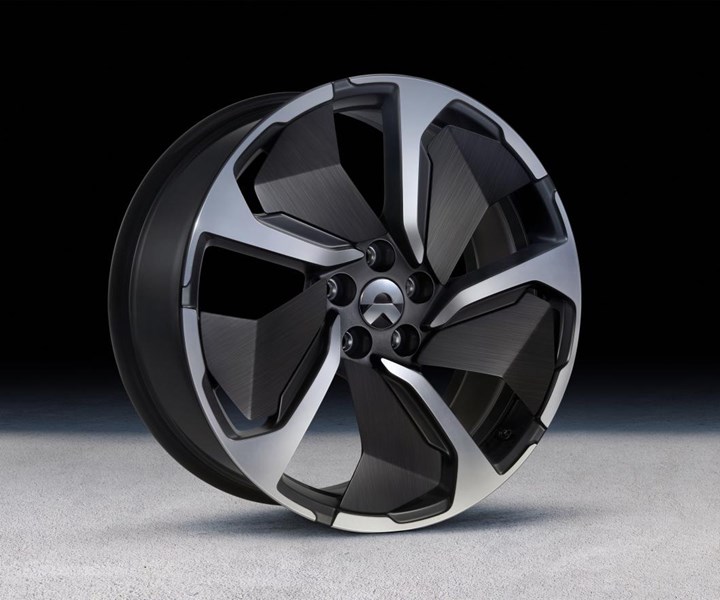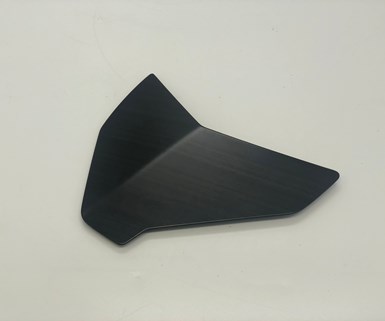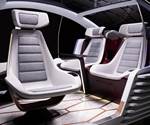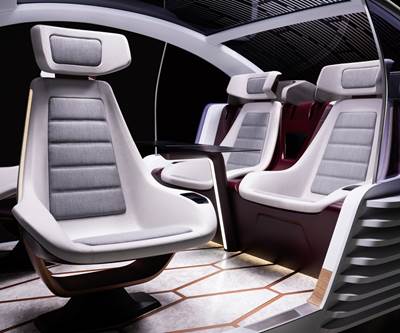Continuous fiber-reinforced thermoplastic composites enable wheel blade for all-electric SUV
Covestro’s Maezio continuous fiber-reinforced thermoplastic (CFRTP) composites are being used in the production of a wheel blade for NIO’s all-electric SUV.

Spoke-like blade inserts for automotive wheels, also known as wheelblades, have become a popular tool for design engineers looking to boost the aesthetics and aerodynamics of the wheel. While carbon fiber is a popular material choice for these non-structural parts,  many designers are looking to showcase the material in different ways besides the traditional woven look that is typically used for exterior components and accent areas. Covestro (Leverkusen, Germany; Shanghai, China) recently announced that its Maezio continuous fiber-reinforced thermoplastic (CFRTP) composites are being used in the production of a composite wheeblade used on the aluminum wheels for the ES6 and ES8 all-electric SUVs manufactured by NIO (Shanghai, China). The material gives OEMs and designers a new alternative to the traditional woven look of carbon fiber, offering a unique appearance with unidirectional carbon fiber optics and a variety of finishing options.
“Designers are looking for new styles to differentiate their applications,” says Covestro automotive composites specialist Florian Dorin.
“Maezio composites are a very unique material because they kind of redefine how beauty is associated with carbon fiber,” adds Yanbing Wang, NIO’s senior CMF designer. “They have set a new aesthetic direction with the unidirectional strands of fibers that feel dynamic and full of energy.”
Introduced in October 2018, Maezio includes unidirectional (UD) reinforced tapes and sheets made from carbon fibers impregnated within a polycarbonate (PC) matrix. Maezio UD tapes can be laminated at different angles to form sheets tuned to meet a variety of performance and mechanical criteria. Resulting sheets are strong, stiff, lightweight and have a natural, unidirectional surface finish.
For NIO’s wheelblade, Maezio sheets are laid up from plies of UD tape to the required thickness. Screw bosses are overmolded and then welded onto the part. Maezio’s thermoplastic matrix system allows it to be easily joined to other functional components during processing. In this particular case, the wheelblade inserts are joined to the spokes through overmolded polycarbonate screw bosses. The use of the same resin ensures adhesion between the screw boss and the wheelblade.
NIO selected Maezio for its wheelblade primarily based on the material’s aesthetic properties and aerodynamics — the blades are a non-structural part designed to reduce wind resistance around the wheels to improve fuel efficiency. However, Dorin also stresses that there were several performance factors that had to be taken into consideration. Wheelblades are subjected to turning forces and high thermal loads created by braking. According to Dorin, Covestro’s Makrolon polycarbonate, which provides the matrix for Maezio, provides good, straightforward adhesion properties and is compatible with a wide range of coatings and decoration processes for designing unique surfaces while still meeting performance requirements.
Covestro was unable to name its coating supplier, but a coating system was developed for the wheelblades that not only retains the beauty of the unidirectional fibers but also provides the required protection. The coating system fulfills rigorous safety and performance requirements including impact, chemical and weather resistance. In addition, the polycarbonate also displays high thermal stability qualities, so the wheelblade insert can survive braking-induced temperatures of up to 150°C. The part itself underwent mechanical testing and was subjected to rolling, bending, durability and braking tests. It was also subjected to high-pressure waterjetting, gravel impact, long-term heat-aging tests, temperature and exposure to such chemicals as gasoline, diesel and brake fluid. The material passed all requirements.

Matt finish. Maezio’s polycarbonate matrix is compatible with a wide range of coatings, enabling a matt-coating system for NIO’s unidirection carbon fiber wheelblade that showcases the fibers yet fulfills performance requirements. Source | Covestro
Based on the success of NIO’s wheelblade, Covestro sees a possible opportunity for use in other aftermarket wheels, and the application gave the company the opportunity to validate the overall performance of the material for other exterior applications such as spoilers. Dorin also noted the material’s potential for use in automotive interior applications.
“Particularly on the interior, everyone fights over every millimeter of constructive space,” says Dorin. “Significant use of composites to make parts thinner while retaining the stiffness and structural properties and enabling aesthetic surfaces is what we see as a big benefit of our material.”
In addition to its aesthetics and durability, Maezio is a potential material enabler for high-volume production. The material can be thermoformed at high yield rates and shorter cycle times to produce millions of parts per year. According to Dorin, cycle times for the material are perhaps slightly longer than typically seen in injection molding, but much faster than processing of epoxy-based materials. Despite numerous technical challenges Covestro and its partners had to overcome, the NIO wheelblade was developed from scratch in only 18 months, and mass production commenced in the third quarter of 2019.
Related Content
MFFD longitudinal seams welded, world's largest CFRTP fuselage successfully completed
Fraunhofer IFAM and partners have completed left and right welds connecting the upper and lower fuselage halves and sent the 8×4-meter full-scale section to ZAL for integration with a cabin crown module and testing.
Read MoreCombining multifunctional thermoplastic composites, additive manufacturing for next-gen airframe structures
The DOMMINIO project combines AFP with 3D printed gyroid cores, embedded SHM sensors and smart materials for induction-driven disassembly of parts at end of life.
Read MoreAssembling the Multifunctional Fuselage Demonstrator: The final welds
Building the all-thermoplastic composite fuselage demonstrator comes to an end with continuous ultrasonic welding of the RH longitudinal fuselage joint and resistance welding for coupling of the fuselage frames across the upper and lower halves.
Read MorePlant tour: Collins Aerospace, Riverside, Calif., U.S. and Almere, Netherlands
Composite Tier 1’s long history, acquisition of stamped parts pioneer Dutch Thermoplastic Components, advances roadmap for growth in thermoplastic composite parts.
Read MoreRead Next
Covestro uses Maezio thermoplastic composites for prototype future mobility interiors
Recently unveiled premium concept focuses on multifunctional design, comfort and lightweight.
Read MoreScaling up, optimizing the flax fiber composite camper
Greenlander’s Sherpa RV cab, which is largely constructed from flax fiber/bio-epoxy sandwich panels, nears commercial production readiness and next-generation scale-up.
Read MoreCeramic matrix composites: Faster, cheaper, higher temperature
New players proliferate, increasing CMC materials and manufacturing capacity, novel processes and automation to meet demand for higher part volumes and performance.
Read More












